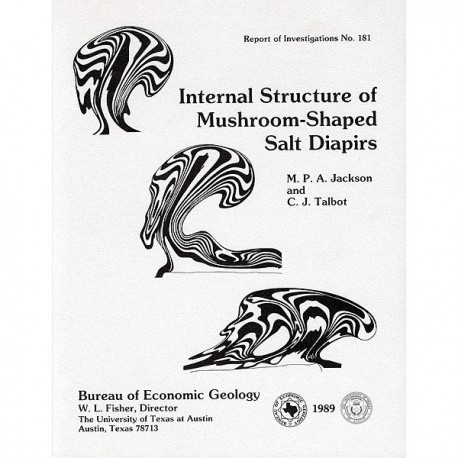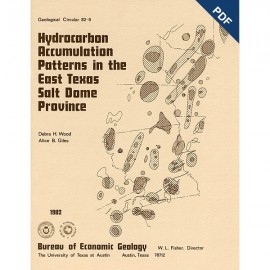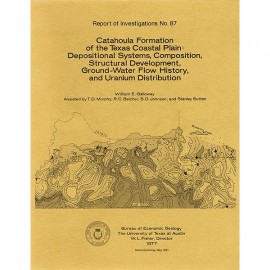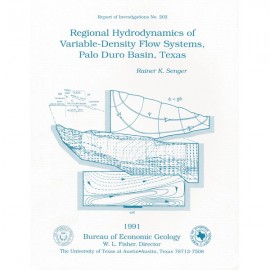Reports of Investigations
-
Books & Reports
- Reports of Investigations
- Guidebooks
- Udden Series
- Geological Circulars
- Down To Earth
- Atlases of Major Oil and Gas Reservoirs
- Texas Memorial Museum Publications
- Environmental Geologic Atlas of the Texas Coastal Zone
- Mineral Resource Circulars
- Other Reports
- Seminars and Workshops
- Handbooks
- Submerged Lands of Texas
- Symposia
- Annual Reports
- Open File Reports
-
Maps & Cross Sections
- Thematic Maps
- Miscellaneous Maps, Charts & Sections
- Geologic Atlas of Texas
- STATEMAP Project Maps
- Geologic Quadrangle Maps
- Cross Sections
- Highway Geology Map
- Energy and Mineral Resource Maps
- Shoreline Change and Other Posters
- Wilcox Group, East Texas, Geological / Hydrological Folios
- Bouguer Gravity Atlas of Texas
- River Basin Regional Studies
- Featured Maps
- Posters
- Teachers & the Public
-
Geological Society Publications
- Gulf Coast Association of Geological Societies
- Alabama Geological Society
- Austin Geological Society
- Corpus Christi Geological Society
- Houston Geological Society
- Lafayette Geological Society
- Mississippi Geological Society
- New Orleans Geological Society
- South Texas Geological Society
- GCS SEPM Publications
- Historic BEG & UT Series
RI0181. Internal Structure of Mushroom-Shaped Salt Diapirs, by M. P. A. Jackson and C. J. Talbot. 35 p., 24 figs., 1989. ISSN: 0082335X: Print.
To purchase this publication as a downloadable PDF, please order RI0181D.
ABSTRACT
Mushroom-shaped diapirs have an overhanging bulb fringed by one or more skirts (peripheral pendant lobes), which can curl inward to form vortices capable of entraining cover rocks to various degrees. The highly complex anatomy of mushroom diapirs, some of which have double and eventriple cores, is analyzed in centrifuged and natural diapirs. We conducted 8 centrifuge experiments, which produced more than 100 model diapirs under acceleration equivalent to 1,200 times that of gravity. The experiments were dynamically scaled to U.S. Gulf Coast salt domes, but the qualitative results are also relevant to salt diapirs in other provinces and to granitoid diapirs rising through metamorphic crust. The centrifuged domes grew under overburdens of constant thickness or under aggrading and prograding overburdens, a new experimental approach. Mushroom diapirs are readily recognized in vertical section but less easily in horizontal section. They share three identifying characteristics: the oldest buoyant unit occurs in a peripheral skirt as well as in the diapiric core; the younger evaporites or their immediate cover are folded into the diapir in crescentic patterns in plan view; and most of the internal folds are downward facing.
Toroidal circulation in rising diapirs leads to a range of bulb shapes that vary with their maturity and with the contrasts in effective viscosity between the diapir and its surroundings. The resulting shapes comprise external simple mushrooms, external vortex mushrooms, internal simple mushrooms, and internal vortex mushrooms. External simple mushroom diapirs have skirts that infold cover rocks. With increased maturity the skirts can curl inward to form an external vortex entraining cover rocks. In contrast, internal mushroom diapirs have skirts confined entirely within the intrusion. With greater maturity these confined skirts also may curl inward, but they entrain only diapiric material.
External mushroom structure results from toroidal circulation of buoyant source and immediate cover having similar effective viscosities. Entrainment of cover by toroidal circulation may be rare in salt diapirs because it appears to require conditions that are realized transiently at certain times and depths in compacting sediments or over long durations in basins where the intruded cover itself contains evaporites, as in Central Iran. Internal mushroom structure results from toroidal circulation confined within the diapir and is probably far more common than external mushroom structure because of isoviscosity within evaporite sequences; we describe natural examples in West Germany and the U.S. Gulf Coast. The internal structure of mushroom salt diapirs elucidates the mechanics of diapiric emplacement and indicates whether an external mushroom shape can be expected and sought by further exploration. Resolving this question is cost effective in exploiting potash ore and vital in the mining engineering of salt caverns. Screens of country rock inclusions entrained into the bulb of an external mushroom diapir could threaten the integrity of a cavern by creating a plumbing system of more permeable rock enclosed in evaporites. In general, engineering within salt structures is likely to be simplest where the evaporites are vertical linear tectonites and more complex where planar fabrics are present.
Keywords: diapirism, diapirs, flow folds, interference patterns, Iran, physical models, radioactive waste, salt domes, salt tectonics, West Germany
CONTENTS
Abstract
Introduction
Factors Controlling the Shape of Mushroom Diapirs
Experimental Results
Introduction
General Anatomy of Centrifuged Mushroom Diapirs
Anatomy of Specific Centrifuged Mushroom
Threefold Diapirs
Fivefold Diapirs
Sevenfold Double Diapirs
Elevenfold Double Diapirs
Vortex Structures
Evaporitic Mushroom Diapirs
Northwest German Plain
Canadian Arctic Islands
Central Iran
Diapiric Contact Strains and Viscosities in Nature
Nature of Diapiric Contacts
Effective Viscosity Contrast
Summary: Mushroom Diapirs and Their Implications to Engineering and Petroleum Exploration
Acknowledgments
References
Figures
1. Types of diapir bulbs
2. Schematic effects of viscosity contrast on shapes of domes based on physical and numerical modeling
3. Vertical sections showing the original configuration of eight models before acceleration in a centrifuge
4. Isometric block diagram of the upper surface of the source layer in model 840319-A
5. Four types of mushroom diapirs shown schematically in vertical half-section together with the terminology of second-order crescentic folds
6. Actual vertical sections through a variety of centrifuged diapirs
7. Nomenclature of schematic mushroom diapirs in vertical section
8. Isometric diagrams of schematic fivefold diapirs
9. Actual vertical and horizontal sections through two centrifuged threefold asymmetric diapirs
10. Actual vertical and constructed horizontal sections through a centrifuged fivefold asymmetric diapir
11. Actual vertical slice of a centrifuged sevenfold symmetric double-stalk diapir
12. Actual vertical and constructed horizontal sections through a centrifuged sevenfold asymmetric double diapir with a draped-arm structure
13. A centrifuged elevenfold double diapir combining a double stalk and a draped-arm structure
14. Vertical and horizontal sections through a hypothetical fivefold asymmetric diaper with vortex structure
15. Actual vertical sections through two centrifuged diapirs at different stages of development toward a sevenfold asymmetric vortex mushroom diapir
16. Vertical section through Asse Dome, a mushroom diapir southeast of Braunschweig, West Germany
17. Vertical section through Hanigsen Dome, a mushroom diapir northeast of Hanover, West Germany
18. Maps and vertical sections of Gorleben Dome, a mushroom diapir between Laase and Trebel, West Germany
19. Vertical sections of four West German salt domes characterized by internal mushroom structure
20. Vertical section of Palangana Dome, South Texas
21. Horizontal section through the northwest sector of Belle Isle Dome, Louisiana
22. Map and hypotheses of emplacement of Barrow Dome, Melville Island, Sverdrup Basin, Canadian Arctic
23. Vertical sections through two symmetric mushroom diapirs in the Great Kavir, Central Iran
Citation
Jackson, M. P. A., and Talbot, C. J., 1989, Internal Structure of Mushroom-Shaped Salt Diapirs: The University of Texas at Austin, Bureau of Economic geology, report of Investigations No. 181, 35 p.






